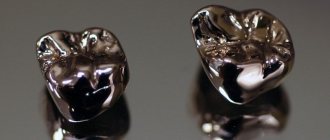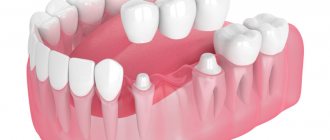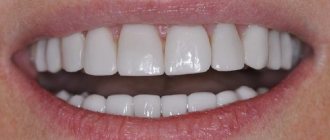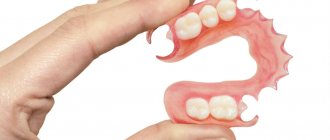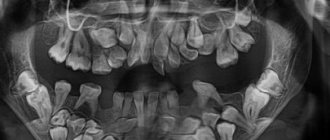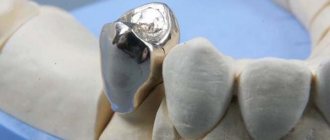Patient Victor, 48 years old (veneers on upper and lower teeth)
Artistic or aesthetic restoration of teeth
Each of us wants to feel beautiful and express emotions openly, and not by covering our mouth with our palm. Therefore, we “repair” chewing teeth only when they lose their functionality - but artistic restoration of the front teeth is often performed solely for aesthetic reasons, when treatment is not necessary.
This direction is also called aesthetic dental restoration or art dentistry. Its task is to form a beautiful smile zone.
Artistic or aesthetic restoration of anterior teeth
Using art dentistry methods, the following congenital and acquired deficiencies of the anterior row can be corrected:
- change in color of one or more teeth;
- incorrect location in the dentition;
- gap between teeth;
- chipped tooth;
- enamel defects;
- anatomically irregular shape and size of teeth.
Artistic dental restoration is always a search for a golden mean between a “Hollywood” and a natural smile. Therefore, a good dentist must be a bit of an artist and sculptor, able to find a balance of shape, transparency and colors.
A professional dentist always has a palette of special paints of 10-12 shades, which allows him to achieve maximum natural color for each patient.
October 2022
Every person sooner or later is faced with the need for dental treatment and prosthetics . He is sometimes faced with the very difficult question of choosing a method and design from the large number of options that modern dentistry offers. Of course, this choice must be made with the participation of a qualified specialist, but still the patient needs to get a clear idea of what the result will be in a particular case. Photos of teeth before and after the events help to do this in the best possible way.
This section presents the results of the work of our specialists, real cases from clinical practice: photos of the front teeth and their restoration, photos before and after orthodontic treatment , dental prosthetics and others.
They will help you better understand how effective a particular technique is. For example, by looking at a photo of the upper teeth before and after a person had veneers installed on his front teeth, you will be able to appreciate the excellent aesthetic effect achieved. with braces and aligners are amazing . And if you are going to have dental prosthetics, but you don’t know which prosthesis is best, look and choose the most suitable option and discuss the possibility of making it with your dentist.
The modern ARTOX clinic on Yugo-Zapadnaya provides its patients with high-quality dental services using the latest achievements of medical science. Our highly qualified specialists with many years of experience will help you achieve an attractive smile for many years.
Make an appointment with a dentist directly on the website or call: +7,.
Make an appointment
Methods for restoring chewing teeth
Restoration of chewing teeth can be carried out using two methods.
1. Direct restoration. In this case, the tooth is built up with composite materials. This option has certain advantages: it is relatively inexpensive and does not require the patient to visit the clinic multiple times. The procedure is as follows:
- preparation for restoration of a chewing tooth (hygienic cleaning, color selection using a special shade scale, anesthesia);
- elimination of carious tissues or removal of an old filling, if restoration has already been carried out previously.
- insulating the tooth from moisture;
- if necessary, installation of a metal or fiberglass pin or stump insert into the root canal;
- restoration of a chewing tooth with light-curing composite materials - involves layer-by-layer application with each layer exposed to light from a special polymerization lamp.
2. Indirect restoration. This is a more costly and time-consuming method, but this restoration of chewing teeth is more aesthetic and durable. If the tooth is less than half destroyed, composite or ceramic inlays are used; if more, crowns made of metal or metal-ceramics are placed:
- Inlays have a number of advantages compared to restoring chewing teeth with filling material: they exactly match the inner surface of the tooth cavity, ideally reproduce the anatomy and function of contact points between teeth, have a long service life, and do not change their appearance during use.
- Crowns. They are used for severely damaged, pulpless teeth that cannot be reconstructed with a filling or inlay. Restoring chewing teeth with crowns gives excellent aesthetic results, prevents their further destruction, and gives the teeth strength and resistance to stress.
Restoration of anterior teeth before and after photos
However, each medical procedure has its own contraindications and limitations that the patient needs to be aware of.
Types of dental crowns
In any clinic, patients can choose the type of future crown themselves, but without the help of a doctor it is very difficult to understand the types of prostheses, as well as evaluate the advantages and disadvantages of orthopedic structures. When choosing a crown, it is important to know what material it is made of.
✔
Metal ceramics.
✔
Solid ceramic.
✔
Ceramics E-max.
✔
Ceramic coated zirconium.
Metal ceramics
Products of this type have a very solid base. They create structures by alloying various metals: chromium, nickel, cobalt, gold, titanium. To make the dental crown look natural, the metal base is covered with ceramics. Layers are applied to the frame, after which the crown is fired to impart strength and integrity.
- Acceptable cost
- Wear resistance.
- Reliability.
- Change in color of soft tissues.
- Allergy to metal.
- Blueness of the gums.
- Significant grinding of the tooth.
Solid ceramic
When restoring teeth in the frontal zone, doctors recommend all-ceramic structures for aesthetic single prosthetics. All-ceramic crowns are made from pressed ceramic without the addition of additional materials. These are quite fragile products, so they are not used in the chewing department.
- Biocompatibility.
- Great aesthetics.
- Durability.
- Fragility.
- Impossibility of performing bridge prosthetics.
- Relatively high price.
E-max ceramics
The problem of the fragility of a material such as ceramics was solved by glass-ceramic crowns E-max. They are not only very durable, but also distinguished by high aesthetics. This is an excellent option for front teeth. The E-max crown looks natural and does not stand out among natural teeth.
- Strength.
- Aesthetics.
- Reliability.
- Natural transparency.
- High price.
Zirconium
In the popularity rating, zirconium crowns have been occupying first place for several years. In terms of strength, aesthetic products made from zirconium dioxide are not inferior to metal, which makes it possible to create orthopedic structures of the highest quality. The hard material enhances the strength of teeth and restores their size and shape.
- Excellent biocompatibility and thermal conductivity.
- Inertness of the material.
- Kink resistance.
- Lack of natural transparency.
- High price.
Ceramic crowns on a zirconium frame
This type of crown is an excellent opportunity to combine strength, reliability, and high aesthetics. The products are as reliable and durable as metal-ceramic crowns. They do not deform during use and serve for a long time. The ceramic layer gives the artificial tooth a natural appearance.
- They look natural.
- Hypoallergenic.
- Withstands heavy loads without risk of damage.
- Quite a high cost.
Restoration with crowns is indicated in the following cases:
- aesthetic defects (chips, stains, cracks, diastemas, trema, curvature, etc.);
- single or complete destruction of teeth with preservation of the root;
- uneven gum line;
- bite pathology;
- pathological abrasion and discoloration of enamel;
- restoration of lost functions (biting, sharing food, diction).
The front incisors are not associated with the chewing function, so there are no strict requirements for the strength of the crowns. The doctor’s task is to recreate the anatomical shape and color of natural teeth, maintain their degree of transparency, and achieve a perfect match of sizes.
Is it possible to install a crown if there is no natural tooth?
In the absence of natural teeth, the integrity of the front row can be restored using implants. Carrying out implantation does not require turning of adjacent elements. The crown is placed immediately after the implantation of the artificial root. This process can last from 2 months to six months.
Before installing implants, the doctor takes impressions or conducts three-dimensional computer modeling to obtain a virtual model of the future structure. Before the permanent prosthesis is fixed, the doctor places a temporary crown on the patient.
Options for restoration of the anterior region with crowns
For patients and dentists, the front teeth have always been the most problematic. In the last century, people were given metal crowns to preserve chewing function. There were no other alternatives. Such structures coped with the chewing function, but looked very unaesthetic, oxidized, caused allergies and galvanic syndrome (taste in the mouth). The most expensive and fashionable were gold dentures. Products made of ductile metal did not oxidize, did not cause rejection, and did not wear out for a long time. But the shiny yellow crowns were conspicuous and did not look like natural teeth, so over time, fashion changed, and this restoration technology was replaced by more modern techniques.
Today, patients have the opportunity to painlessly and quickly get rid of all defects associated with damage or loss of teeth in the frontal area, including the complete absence of dentition. In shape, shade and transparency, artificial analogs are almost no different from natural teeth, and their strength allows you to forget about any problems for a long time.
